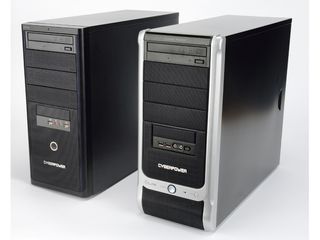
That's right, ladies and gentlemen. In the blue corner, running in at 2.33GHz, is the Intel Core 2 Quad Q8200 (Yang). And in the red corner, we have the AMD Phenom II X3 710 (Yin), running in at 3.12GHz.
Both are middleweight, multi-core hitters and each one has a point to prove in this grudge match. One rig is destined for a KO and the other will lift the winner's belt. So, without further ado, it's time for round one and, in the words of Apollo Creed, "ding ding".
To help set-up this prize fight, Cyberpower built two identically priced £550 systems for us – one powered by an Intel/Nvidia partnership; the other an entirely AMD-powered contender. Fixing a price point like this gives us a better insight into the real performance you're getting in return for your hard-earned paycheck.
In other words, we can see which side is beating the other into submission with its technology on a value scale, rather than comparing it in terms of raw speed. Why? Well, let's face it, although it's fine for Nvidia, AMD or Intel to fire out an Extremely Exclusive Reassuringly Expensive Edition to claim the performance crown, if no one can afford to buy it, what does that really mean?
For 90 per cent of the time, the entire computing world is focused on the high-end. The fastest product the industry giants can fire out of their labs and into our consumer gullets gets the most column inches, web space and Diggs.
But who rules the mid-range roost? Which of Intel or AMD is really winning the performance war for reasonably priced systems? It's a question that, mid-recession, is more pertinent than ever.
Chippy chips
Get daily insight, inspiration and deals in your inbox
Get the hottest deals available in your inbox plus news, reviews, opinion, analysis and more from the TechRadar team.
Let's start by taking a closer look at the AMD contender. For processing duties, the latest AMD Phenom II is bolted into an AM2+ socket, or the triple-core X3 710 to be precise. Built on the latest 45nm process, this three-headed monster offers the new enhanced 6MB L3 cache, faster 2GHz HyperTransport link and 'fixed' global Cool 'n' Quiet power management.
Rated at 2.6GHz, Cyberpower provide the AMD systems pre-overclocked to 3.1GHz. This is partly because it can, but mostly to make sure the systems hits the magical Windows Vista 5.9 score, which a stock X3 won't quite make.
Pitted against this is the latest addition to Intel's entry-level quad-core processor range, the Core 2 Quad Q8200. If you thought the Q6600 was slow enough already, then Intel seems to have gone out of its way to make the Q8200 even slower.
At 4MB in total, its L2 cache is half the size of previous Intel quad core processors and it's clocked at a leisurely 2.33GHz, but there's a little bit of light at the end of the tunnel in the form of its 1.33GHz front side bus.
It's an interesting match up; are four legs better than three? In order to find out, we ran a raft of tests to attempt to get a good idea of how the two matched up in the real world, including HD video encoding and decoding, the multithreaded synthetic tests from PCMark 05 and the usual gaming, memory and 3DMark06 tests.
Some of these tests are better optimised for quad-core systems than others, primarily the HD video tests, because it's far easier to multi-thread decoding a video stream than most other tasks.
As it turns out, the Intel system's greatest blow was struck in our x.264 HD encoding task, with it encoding 13.6fps against the AMD's 12.2fps result. No doubt that's down to the use of that fourth core, combined with Intel's excellent Core 2 SIMD implementation.
Clocked at its stock speed, the AMD would be down in the mid-10fps, leaving the Intel system with a healthy 30 per cent lead. However, a close call that went to AMD was 1,080p HD decoding. With an average CPU use of 15.1 percent for AMD against 17 per cent for the Intel, it seems the AMD makes better use of those hot little cores, with both systems peaking at 25 per cent use.
Most Popular


